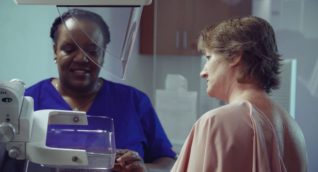Diagnostic mammography is ordered by a medical provider for women or men with symptoms of breast disease such as a lump, skin changes, or nipple discharge. Diagnostic mammography may also be recommended for women with a history of breast cancer or to evaluate problematic areas detected on a screening mammogram. If you have breast symptoms that are concerning, your provider should order a diagnostic mammogram. Screening mammography is for women who do not have breast symptoms. It is meant to detect cancer even before symptoms occurs.
ARA uses advanced 3D mammography technology for our mammograms. 3D technology takes multiple images of the breast and uses computer reconstruction to create 3D images of the breast. The breast is compressed between a clear plastic paddle and an imaging detector and the X-ray tube moves in an arc over the breast, capturing different angles. ARA radiologists can then scroll through all the images much like a book – one page at a time – to gain a better understanding of the structures inside your breast. Benefits of 3D mammography technology include:
- It is more effective for finding breast cancer. 3D mammography has an up to 41% higher detection rate for invasive breast cancer than traditional mammography.
- It results in fewer callbacks. Because 3D mammography is so thorough, fewer women are called back for further exams, resulting in less expense and anxiety for the patient.
- It uses low-dose radiation, with a dosage comparable to the older 2D exam.
- It’s convenient. 13 ARA locations offer 3D mammography in Central Texas. The exam only takes 30 minutes and ARA offers extended appointment hours.
To help you understand your risk for breast cancer and discuss it with your doctor, you can use the Breast Cancer Risk Assessment Tool developed by the National Cancer Institute of the National Institutes of Health.
Benefits
- Diagnostic mammography, especially when 3D mammography is used, is one of the best ways of evaluating abnormal breast symptoms. The survival rate for early-stage breast cancer is 98%, meaning early detection is key to recovering from breast cancer. Mammography helps detect cancers up to two years before they can be felt.
- Mammography has been shown to reduce the number of breast cancer deaths.
- No radiation remains in the patient’s body after an X-ray exam and X-rays typically have no side effects.
Risks
- Mammography uses a low dose of radiation, but the benefit of an accurate diagnosis far outweighs the risk. Get more information from radiologyinfo.org. Get more information on radiation safety at ARA.
- It is possible that you will get a “false positive,” as diagnostic mammograms may indicate the need for more testing, such as further mammogram or ultrasound. Most of these exams show normal results. If there is an abnormal finding, you may need a biopsy for further diagnosis.
- Women must always let the mammography technologist know if they are pregnant. An alternate exam such as ultrasound may be recommended.
- A diagnostic mammogram is like a screening mammogram but may include additional views or special techniques to examine a suspicious area or to eliminate shadows produced by overlapping layers of breast tissue.
- When you arrive, you will be asked to change into a gown.
- A registered female technologist will perform your examination.
- While you stand close to the unit, the breast being examined will be compressed for a few seconds between the imaging detector and a clear paddle while the X-rays are taken. This may be slightly uncomfortable, but it is necessary. The compression reduces the thickness of the breast resulting in a lower radiation dose, it spreads out the breast tissue to make it easier to see through the tissue, and it helps prevent movement which can make the image blurry.
- When the exam is completed, you will be asked to wait until the radiologist examines the images. The radiologist may ask for more views of the breast, depending on what is seen on the first images and may recommend that you have further exams, such as an ultrasound or MRI, in order to fully examine a suspicious area.
- A diagnostic mammogram may take up to one hour depending on how many views are needed.
- Diagnostic mammograms require a provider referral. Please bring a copy to your appointment.
- If you have had prior breast imaging at an office other than ARA Diagnostic Imaging, please inform the scheduler or bring those images with you for comparison if possible. Also inform the scheduler if you have breast implants.
- Wash breasts and underarms and do not apply any deodorant, powder or cream.
- Since you will undress from the waist up for the exam, you may wish to wear a two-piece outfit.
To schedule a diagnostic mammogram, please use our convenient online scheduling tool in the Patient Portal or you may call our scheduling team at (512) 453-6100 or toll free at (800) 998-8214. A referral from your healthcare provider is required to make an appointment.
You will receive the results of your diagnostic mammogram while you are at your appointment, and your physician will receive the written report.
If a biopsy is recommended, a radiologist will consult with you, and you will speak with one of our certified breast navigators. ARA schedulers can help you move quickly to the biopsy appointment.
Results will be sent to your medical provider. Our breast navigators are available to help you with education, logistics, and any concerns you might have.
ARA wants to provide a safe, comfortable environment for patients and staff.
Patients may either bring or request a chaperone to accompany them during their mammogram to help protect and enhance their safety and comfort.
When requested, ARA will attempt to provide a chaperone with whom the patient feels comfortable. If a patient’s chaperone request cannot be accommodated, the patient will be given the opportunity to reschedule their exam.

